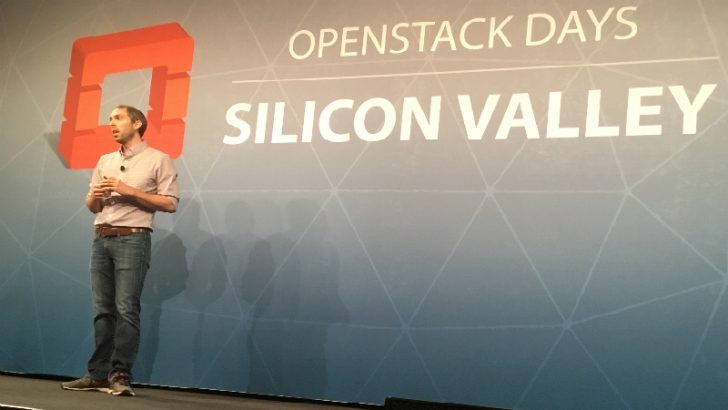
OpenStack is moving towards being the biggest ever open source success. Customers have made the jump from test and evaluation to production in ever increasing numbers. The question that some inside the open source and the OpenStack community are asking themselves is “what comes next?”
It’s a good question and one that few people have an answer for. One who does is Jonathan Bryce, Executive Director, OpenStack Foundation. At the OpenStack Silicon Valley Days conference he outlined three things OpenStack has to do in order to continue to be successful. These are innovation, collaboration and learning how to duplicate success.
Breaking out of the Zero-Sum mindset
Bryce believes that one of the limitations that OpenStack has to overcome is the zero-sum mindset. He explains this as: “To be successful companies believe that they have to take business from competitors. The more successful you are the more of the market you own. It’s a zero-sum approach which also limits the ability of a market to grow.”
The problem with this approach, according to Bryce, is that it doesn’t fit with the evolution path that mankind is on. He says: “Everything we do as humans for the next century will depend on increasing amounts of computing power. As it expands and grows we will need to change how we manage and provision it.”
This approach is in direct contrast to the zero-sum approach. The ‘winner takes all’ approach that many companies operate is too restricting. Delivering the compute capacity to unlock the next century of innovation means giving the world the compute capacity it requires. The only way to do this believes Bryce is through open tools and a radical shift in mindset. That shift needs to go from versus to and. He refers to this as a positive sum future.
What role does OpenStack have in a positive sum future?
Unsurprisingly Bryce believes that OpenStack can play a significant role in a positive sum future. He says: “What we’ve really created is a competitive marketplace for ideas that values collaboration. We’ve created technology that 1,000’s of people are relying on. How do we build on that?”
Bryce’s solution is not to reinvent anything. What he wants is the community to continue to innovate and collaborate. These two things will deliver some of the solution but they are not enough on their own. The missing part is to make successes easier to duplicate. This is nothing new and many organisations struggle to repeat their successes. So what did Bryce have to say about the need to innovate, collaborate and make success easier to duplicate?
Innovate
OpenStack has brought people together to solve problems for the cloud. It created new communities and projects. What will enable us to continue to innovate? Users. They are already beginning to create new workloads such as the Internet of Things, machine learning and analytics.
These are information rich and OpenStack must continue to expand what it offers for the long term. It needs to decide what technologies such as PaaS, languages and containers to support. Then it must continue to push the envelope to find ways to bring in new technology and give them a place on OpenStack. One example is patterns and frameworks. While these have been used successfully to build OpenStack there is a need to start creating new ones for the future.
Collaborate
OpenStack and open source have not done any of this alone. They have proven that collaboration between communities can happen and deliver new solutions. Bryce cited the success of the LAMP stack which enabled developers to start writing dynamic web applications. This is just one wave of app innovation. Another wave was the success of iOS and Android to unleash mobile applications. Every company is now looking at building its own apps.
The next wave of app development Bryce believes will be in cloud frameworks. Interestingly he does not see just one set of APIs or frameworks but hundreds of them. This will come in areas such as machine learning, algorithms and autonomous stuff. Key to this will be collaboration and working with other communities and technologies. This will help define the right stack for cloud app developers to unleash another wave of innovation.
Kubernetes has been a popular subject at recent meetings according to Bryce. Among the ways of taking this forward is using Kubernetes to orchestrate OpenStack services. This means connecting them together to create a reliable, scalable, programmable infrastructure. SAP is already running IoT workloads using Kubernetes as its orchestration engine. Bryce says that they are not the only ones doing this and it will be interesting to see where this goes. Bryce sees collaboration to build the right stack will help unleash future innovation.
Make success easier to duplicate
OpenStack has a well earned reputation for being difficult to setup. Bryce believes that is being addressed with the last few released heavily focused on simplifying installation and management. The OpenStack community has focused on solving the technology issues. What is has not dealt with is moving beyond the technology to address culture, processes and people inside organisations.
Bryce rightly points to the success stories. He said: “There are dozens of clouds with thousands of nodes running big workloads on them. To get there, companies had to go through multiple iterations. We need to help them duplicate that and make it easier.”
Part of the solution is the consumable content that the OpenStack Foundation has created around these topics. It has moved beyond just addressing the technologists with books dealing with OpenStack for business and the Path to Cloud. They are aimed at helping enterprises get started organisationally and deal with issues such as what is needed when putting together a cloud team. Another part of this Bryce believes is getting people to talk about success.
Training required to deliver OpenStack
In Austin the OpenStack Foundation began to address the problem of talent training. It has launched a number of OpenStack individual certifications. The OpenStack Administrator is a baseline certification. It covers the standard operations needed to run an OpenStack cloud. The online skills-based exam costs $300 with discounts for students. Bryce said that the OpenStack Foundation was trying to keep the cost low to make it accessible. There is also student pricing for the exam. Bryce admits that there is a need to expand the talent pool for OpenStack experts.
To take this further Bryce wants to see an OpenStack Academy. It will be interesting to see how long it takes to achieve this. There are a number of models that the OpenStack Foundation can follow to make this work. What it will have to do is convince both employers and candidates that the certification is worth it. This should not be difficult. As OpenStack continues to grow there is already a big shortage of people. Creating an academy that delivers the right training to enable people to advance their careers should be easy.
Conclusion
Much of what Bryce is saying is no different to every other industry. Those companies that fail to innovate and create repeatable success soon disappear. Many use their partner networks to build collaborations to expand their products.
At the moment OpenStack has no real competitor in the market. So far it has been the new disruptive technology. That is changing as OpenStack matures and goes mainstream. What Bryce is seeking to do is send out the message that it must not sit back and consolidate what it has. If OpenStack fails to innovate and evolve then it will eventually find itself being disrupted by newer technologies.


























